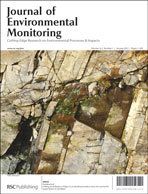Evaluation of a temporal trend heavy metals contamination in Posidonia oceanica (L.) Delile, (1813) along the western coastline of Sicily (Italy)
Abstract
The use of biological species in the monitoring of marine environmental quality allows the evaluation of biologically available levels of contaminants in the ecosystem and the effects of contaminants on living organisms. The seagrass Posidonia oceanica is a useful bioindicator because through the lepidochronology technique it is possible to obtain a historical contamination trend of a given area. This study aims to assess the temporal trend contamination by heavy metal investigations on dead sheaths of 100 samples of P. oceanica collected in the Protected Marine Area of “Plemmirio” (Sicily) and in the Siracusa bay. Important results were obtained because data show a significant negative temporal trend for the metals analysed especially for As, Co, Cr, Hg, Pb, Se, U and V that in the past had higher concentrations, with a stronger contamination in the Plemmirio area, the site much more exposed to the pollution of the nearby petrochemical complex. This study confirms the relevance of the use of P. oceanica as a biological


 Please wait while we load your content...
Please wait while we load your content...